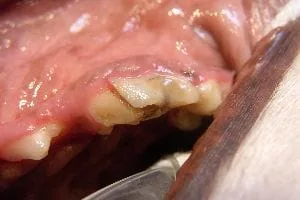Cats and Dogs with Broken or Fractured Teeth
Broken or fractured teeth are a common finding in veterinary practices. In most cases, broken teeth are caused by the significant biting force dogs can generate coupled with the items they chew. Objects that are notorious for breaking teeth include cow hooves, real bones, rocks, ice, and hard plastic bones.

Cats, as well as dogs, are susceptible to fractured teeth following trauma such as falling from heights, being hit by a car, or rough play. The result is often a tooth fracture that may or may not extend into the pulp canal within the tooth. The pulp canal is a chamber within the tooth that houses the pulp tissue (the blood vessels and nerve within the tooth). If the fracture does not enter the pulp canal, simply smoothing any rough enamel edges and sealing the tooth with a bonding agent will suffice in most cases. If the fracture opens the pulp canal, which houses the blood and nerve supply to the tooth, then the tooth will be acutely painful.
Most pets, however, do not show obvious signs of pain. These pets will typically chew on the opposite side of the mouth or avoid using the broken tooth until the nerve dies in a matter of weeks to months. Until the nerve dies, the exposed pulp is sensitive and most pets will react if it is touched or otherwise stimulated. Once the nerve dies, the open pulp canal is an area that food, saliva, debris, and bacteria can enter the tooth resulting in an infection of the pulp tissue. The pulp tissue enters the tooth at the tip of the root or roots, and as the infection overtakes the pulp, it extends through the root tip to the bone in this area. Again, most pets will not show signs of an infected tooth. The vast majority of pets with broken, infected teeth will not swell or drain pus at this site as one might expect, but the infection is managed by the immune system and smolders. The pain associated with the broken tooth changes from an acute pain to a chronic throbbing ache.
The immune system will constantly fight the infection to keep it under control. In less than half of the patients, swelling will appear and pus will drain through the skin or gum tissue in the region of the root tips. Antibiotics will help control the infection temporarily, but the problem recurs after discontinuing the medication. The infection will persist until the source of the infection, the infected pulp, is removed either by extracting the tooth or by root canal therapy. The age of the patient, extent of infection, amount of tooth or root damage, periodontal health of the tooth, duration of pulp exposure and importance of the tooth will help decide which treatment is best.
'The Pet Dentist' - Location, Map, Directions. Offices serving greater Tampa Bay, Clearwater, St Petersburg, Brandon & Bradenton :





